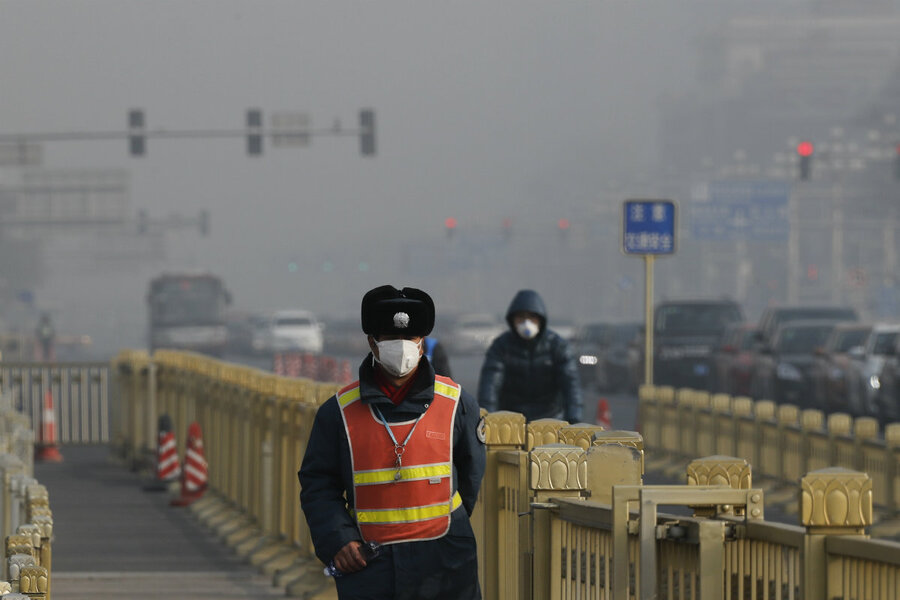Can China’s new $360B renewable energy plan stop 'Airpocalypse'?
Loading...
Chinese officials rolled out a detailed plan this week signaling a major commitment to renewable energy, even as some Chinese cities experienced historic levels of smog pollution.
Air pollution was so bad that 32 cities in China received the most severe pollution warning, while Beijing and 26 other cities were placed under the second severe smog tier, NBC News reports. Some media outlets dubbed it "Airpocaloypse"
In the same week, the government’s energy agency said the country plans to spend at least $360 billion on renewable energy sources such as solar and wind by 2020, indicating a transition away from fossil fuels. The challenge for Beijing is balancing economic growth (largely still driven by fossil fuel powered factories) with goals for a cleaner environment. The effort seems to be taking place in fits and starts.
This most recent smog emergency has prompted government officials to shut down factories and construction, limit the number of cars on the road, and close schools while urging residents to stay indoors and avoid outdoor activities.
A time-lapse video taken by Chas Pope last Sunday captured the thick noxious clouds of smog that blanketed Beijing in 20 minutes.
A few days before Chinese cities were placed under “red” or “orange” alerts – the two most severe warnings in China’s four-tier system, China’s Ministry of Environmental Protection said on Dec. 31 that they held 2,682 local officials accountable for poor environmental protection efforts and fined smog offenders of anti-pollution laws approximately US$35 million in recent inspections, according to Xinhua.
Since 2014, some Chinese cities have been able to reduce air pollution by up to 20 percent, amid growing enforcement of environmental laws and a crackdown on corruption. But as China's economy has slowed, in 2016 the government has incentivized factories to boost economic output, but often at the expense of air and water quality.
In a December 16 analysis, Greenpeace says an expansion of coal-fired production, following a 2016 economic stimulus package, is the reason behind a spike in the air pollution in recent months.
The uptick [in pollution levels] correlates directly to increased steel production in the Beijing/Tianjin/Hebei area known as Jingjinji. A short term economic stimulus package designed to prop up the economy was released this year, that has boosted steel and cement output. With the increase of steel prices came an expansion of coal-fired production in steel producing areas, and with it, a halt in air quality improvement.
Against this backdrop, the nation’s National Energy Administration laid out a plan Thursday aiming to “dominate one of the world’s fastest-growing industries,” the New York Times reports.
“Renewable energy is a principle part of China’s non-fossil fuels and an important segue for China’s future energy transformation,” the agency said in a statement.
This plan expects to create more than 13 million jobs in the renewable energy sector, substantially reduce the emission of greenhouse gasses, cut the amount of soot and the use of water within the next three years, the statement said.
The agency said the plan is a major push toward meeting the goal of making renewable energy 15 percent of China’s total energy consumption by 2020. The country aims to make it 20 percent by 2030.
But some environmental experts have criticized the plan.
Lauri Myllyvirta, a Greenpeace research analyst based in Beijing, told the New York Times that the plan omits any specific target to curtail coal consumption - a major source of pollution.
Coal is not only a source of generating electricity, it also powers industrial activities such as steel and cement production, and is key to meeting the China’s growing energy needs.
Other researchers are skeptical about the prospect of China's plans to ramp up the renewable energy industry as able to put a significant dent in its air pollution. There's no question that China is moving quickly at home and abroad on solar energy – Greenpeace estimates that in 2015 China installed an average of more than one wind turbine every hour of every day.
But in an annual report of the International Energy Agency, Heymi Bahar writes that China’s increasing electricity demand far surpasses the country’s renewable energy growth, despite its leading position in the field worldwide.
[Editor's note: An earlier version of this story carried an incorrect dateline.]








